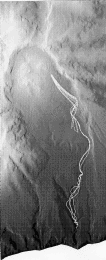
MVO/VSG - Open Scientific Meeting
27 November 1996
Simulations of pyroclastic flow: 12 may 1996
flows and the threat of future flows
G. Wadge1, P. Jackson2, A.W. Woods3

G. Wadge1, P. Jackson2, A.W. Woods3
1ESSC, University of Reading
2Seismic Research Unit, UWI
3School of Mathematics, University of Bristol
During the current eruption at Soufriere Hills Volcano pyroclastic flows have been generated by gravitational collapse of the growing dome. Individual blocks break off from the chilled carapace of lava, slide, roll and bounce downslope and disintegrate. If this process is continuous increasingly hotter interior lava is exposed. Above some threshold this process produces pyroclastic flow. This involves a dense undercurrent of blocks and ash, constrained by topography and a surging cloud of hot ash and gas feeding off the underlying flow. At Montserrat between March and September 1996 these flows have travelled up to 2-3 km at velocities of several tens of m/s.
The flows have been largely confined to English's Crater and the Tar River area. This may continue to be the case throughout the eruption, but the possibility of pyroclastic flows travelling to the west (to Plymouth) and north is real. We are evaluating this possibility by simulating the paths of pyroclastic flows using computer programs.
On May 12, 1996 four pyroclastic flows were generated from a narrow collapse scar on the northeastern side of the dome. Two of them entered the sea. We have chosen to simulate these flows because the topography over most of their path was largely the same as that mapped prior to the eruption, the deposits themselves were well-mapped and video footage existed of the last few hundred metres of flow into the sea.
We have used a modified version of the FLOW program of McEwen and Malin (1989) using a digital elevation model (DEM) of the Tar River catchment with 5 m horizontal resolution and 1 ft vertical resolution. The program models the flow as a gravity current resisted by Coulomb, viscous and turbulent friction. The Coulomb resistance involves cohesion and sliding friction terms. Ignoring cohesion gives the "energy-line" model used by Wadge and Isaacs (1988). Viscous resistance is usually non-Newtonian , the Bingham flow version of which involves a yield strength (equivalent to cohesion + frictional strength) and a viscous term proportional to viscosity and the velocity gradient. Turbulent resistance may come from turbulent ground shear, air shear and ploughing resistance.Their influence is proportional to the square of the velocity. Once parameterised the program tracks the movement of individual flow paths over the topography, stopping at some minimum velocity threshold (taken as 2 m/s). We are able to model the path of the 12 May pyroclastic flows using starting velocities of about 40 m/s, thicknesses of about 2 m and both viscous and turbulent resistance terms (Yield strength = 100 Pa, angle of friction = 0.14, viscosity = 15 Pa s, coefficient of turbulent ground shear = 0.008). Simulated flows give near terminal velocities of about 10-5 m/s, similar to those observed, but we have no other constraints on the velocity histories of the models.
Running models with such parameterisations to the west, down Gages Wall shows the equivalent behaviour that would endanger Plymouth. We are exploring a number of improvements to this approach:

A simulation of the 12 May 1996 pyroclastic flow path.
Each trajectory follows an independent path dependent on its starting position.
This simulates the gravity flow component of the flow
(that produces the block-and-ash flow deposits), not the surge.